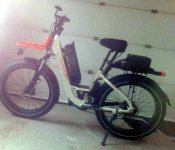HillCruiser
10 W
- Joined
- Jan 19, 2022
- Messages
- 81
On speed control, It appears that it can be achieved using the cycle analyst alone.
Throttle mode can be changed to "speed" and the autocruise function need setup,
after that it looks like the CA will control the bike speed when autocruise is activated.
Maybe one of the CA gurus can confirm.
This got thinking that the inclinometer signal could be sent directly to the CA and
used to control the power output; eliminating the need for the Arduino.
Rather than come in through the throttle, maybe inputting the inclinometer
signal to the Aux Analog may be the way to go; leaving throttle operation unaffected.
The CA looks like it maybe was setup to do this type of experimental operation;
if so, what an amazing device!
The roads turned to slush yesterday and refroze but the plow caught it before the freeze.
The new snow fell and now the fat tires are noiseless and there's just a slight whirrrr of the motor.
Short ride and a bit treacherous on the curves but still a good one.
So I have a new set of data. I t had to discard the previous set because I had parsed out the GPS sentence
but the Grin Trip analyzer is looking for a complete NMEA sentence.
Donn, thanks for your input. Inclinometer with speed trim could well be the solution for stable control
since the signals are so noisy. Sorry it took me 18 more posts to "see the light"...
Throttle mode can be changed to "speed" and the autocruise function need setup,
after that it looks like the CA will control the bike speed when autocruise is activated.
Maybe one of the CA gurus can confirm.
This got thinking that the inclinometer signal could be sent directly to the CA and
used to control the power output; eliminating the need for the Arduino.
Rather than come in through the throttle, maybe inputting the inclinometer
signal to the Aux Analog may be the way to go; leaving throttle operation unaffected.
The CA looks like it maybe was setup to do this type of experimental operation;
if so, what an amazing device!
The roads turned to slush yesterday and refroze but the plow caught it before the freeze.
The new snow fell and now the fat tires are noiseless and there's just a slight whirrrr of the motor.
Short ride and a bit treacherous on the curves but still a good one.
So I have a new set of data. I t had to discard the previous set because I had parsed out the GPS sentence
but the Grin Trip analyzer is looking for a complete NMEA sentence.
Donn, thanks for your input. Inclinometer with speed trim could well be the solution for stable control
since the signals are so noisy. Sorry it took me 18 more posts to "see the light"...


![ATTACH]](/sphere/proxy.php?image=http%3A%2F%2F%5BATTACH+type%3D%22full%22+alt%3D%22Nano+vs+Stealth.jpg%22%5D312595._xfImport%5B%2FATTACH%5D&hash=2ebaf4e285c24a8603e96b8744b74abf)
